| Srl | Item |
| 1 |
ID:
155358


|
|
|
|
|
| Summary/Abstract |
ANALYSIS OF THE HISTORY of the Russian policy with regard to South Slavic peoples generally boils down to considering Russian-Serbian relations, often unjustifiably leaving out the Slovenians, Croats, Macedonians and others. However, all these peoples have also strived to establish close relations with us and use Russian authority and influence in the struggle for the interests of their own, including, admittedly, in conflicts with each other. For many centuries, Russia has been developing contacts with these peoples, and their cultures kept intertwining.
|
|
|
|
|
|
|
|
|
|
|
|
|
|
|
|
| 2 |
ID:
089828
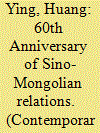

|
|
|
|
|
| Publication |
2009.
|
| Summary/Abstract |
An international academic symposium for the "60th anniversary of the establishment of diplomatic relations between China and Mongolia:Cooperation and Development" was held on May 12-13th at China Institutes of Contemporary International Relations. Guests from the Institute for Strategic Studies of Monglia, the institute of International Studies of Monglia Academy of Sciences, the Government Agency of Mongolian National Development and Innovation Committee, the National University of Mongolia, the Mongolia Development Institute, the Embassy of Mongolia in China took part in the symposium.
|
|
|
|
|
|
|
|
|
|
|
|
|
|
|
|
| 3 |
ID:
170741
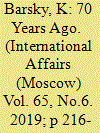

|
|
|
| 4 |
ID:
057270
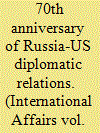

|
|
|
| 5 |
ID:
180306
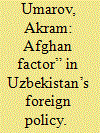

|
|
|
|
|
| Summary/Abstract |
This article examines the historical development of Uzbekistan's stance on the situation in Afghanistan, outlines its main stages, achievements and challenges, investigates the major initiatives of Tashkent on solving conflict in the neighbouring country before and after 2016, the major priorities of its contemporary foreign policy towards the Afghan conflict, and the Uzbek government's expectations from the upcoming developments in Afghanistan.
|
|
|
|
|
|
|
|
|
|
|
|
|
|
|
|
| 6 |
ID:
125532
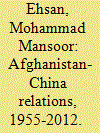

|
|
|
|
|
| Publication |
2013.
|
| Summary/Abstract |
When Cheyang Jeyong the first ambassador of Han Dynasty traveled to north Afghanistan for diplomatic mission in 130 BC it marked the first diplomatic mission between Afghanistan and China. Basically, the relations between Afghanistan and China have been dominated broadly by the Silk road as the trading caravans were crossing the regions
|
|
|
|
|
|
|
|
|
|
|
|
|
|
|
|
| 7 |
ID:
132417
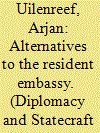

|
|
|
|
|
| Publication |
2014.
|
| Summary/Abstract |
Increasingly integrated in a common political entity, the European Union's member states are exploring new avenues to shape and maintain their mutual relations. This analysis describes three alternatives to the traditional resident embassy by which ministries of foreign affairs within the EU attempt to maintain diplomatic networks. The models discussed are secondments within member states' capitals, visiting ambassadors, and co-location and co-operation. In other words, with regard to different modes of representation, member states can consider diving in, stepping back, or pooling and sharing. These developments shed light on the ways in which the diplomatic machineries of the member states are trying to adapt to the demands of a "post-Westphalian" environment such as that of the EU.
|
|
|
|
|
|
|
|
|
|
|
|
|
|
|
|
| 8 |
ID:
065013
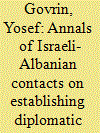

|
|
|
| 9 |
ID:
133736
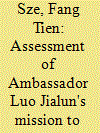

|
|
|
|
|
| Publication |
2014.
|
| Summary/Abstract |
Luo Jialun (1897- 1969) was the first Ambassador of the Republic of China to India. In his tenure as Ambassador to India (1947- 9), he had intensive interactions with leaders of newly independent India. He was also often consulted for his expertise and opinions related to nation building. Unfortunately, his ambassadorship ended in December 1949 after New Delhi decided to recognise the communist-ruled People's Republic of China and break off diplomatic ties with the Republic of China. Acknowledging that Luo's diplomatic career in India has not received much publicity, this article tries to establish the significance of his India mission. The article argues that Luo should not be blamed for the severance of diplomatic relations between India and the Republic of China, which was affected by the global and regional systemic changes resulting from the defeat of the Nationalist government in China. Despite the eventual severance of ties, Luo's passage to India from May 1947 to January 1950 was largely productive. He had relied on his knowledge and experience to fulfil his assignment as an envoy.
|
|
|
|
|
|
|
|
|
|
|
|
|
|
|
|
| 10 |
ID:
128435
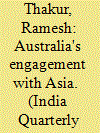

|
|
|
|
|
| Publication |
2013.
|
| Summary/Abstract |
The ebb and flow of coping with Australia's identity dilemma as a European settler society located on the geographical edge of Asia leads to bouts of agonising, excitement and temporising. This has been given particular cogency with the power shift underway from the trans-Atlantic to the Asia-Pacific. The 2012 White Paper set 25 national objectives to be met by 2025, with targets ranging from improving trade links and increasing scholarships to teaching priority Asian languages. But in this transactional embrace of Asia that highlights economic and trade links, gaps might open up between ambition and delivery, especially amidst continuing evidence of insensitivity to how Asians forge lasting relationships. Ties with China are dominated by trade but security concerns remain. Relations with India should improve with the removal of the nuclear issue as an irritant and growing trade and tourist numbers. Japan remains an important trade and diplomatic partner. And geography and demography ensure that Indonesia is no less important to Australia than Asia's big three.
|
|
|
|
|
|
|
|
|
|
|
|
|
|
|
|
| 11 |
ID:
186788
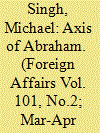

|
|
|
| 12 |
ID:
034593
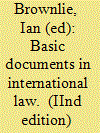

|
|
|
|
|
| Edition |
IInd edition
|
| Publication |
Oxford, Oxford University Press, 1972.
|
| Description |
x, 284p.
|
|
|
|
|
|
|
|
|
|
|
|
Copies: C:1/I:0,R:0,Q:0
Circulation
| Accession# | Call# | Current Location | Status | Policy | Location |
| 010022 | 341/BRO 010022 | Main | On Shelf | General | |
|
|
|
|
| 13 |
ID:
089805
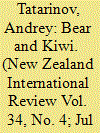

|
|
|
|
|
| Publication |
2009.
|
| Summary/Abstract |
New Zealand and Russia established official relations in 1944 at the time when both were at war with Nazi Germany. But ties between the two countries go back much further. The first Russian to visit New Zealand did so in 1821, members of the first Russian Antarctic expedition led by Captain Bellingshausen.
|
|
|
|
|
|
|
|
|
|
|
|
|
|
|
|
| 14 |
ID:
129890
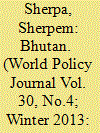

|
|
|
| 15 |
ID:
114472
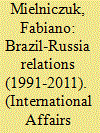

|
|
|
|
|
| Publication |
2012.
|
| Summary/Abstract |
CONSIDERING THE CONTINUITY between the Russian Empire, the Soviet Union and the Russian Federation, bilateral relations between Brazil and Russia exceed 180 years. However, a number of factors contributed for this relationship to remain incipient in most of its history - and the location of Brazil in a United States' zone of influence since its independence deserves special attention among them. In fact, the periods of lower intensity in relations with Moscow were those of greater animosity between the North American neighbor and the Soviet Union, as illustrated by the severance of diplomatic relations with the USSR in the beginning of the Cold War. In contrast, relations are restored in the context of the Independent Foreign Policy (1961) and start to intensify again in the 1970's, due to both the abandonment of the automatic alignment to the United States, adopted after the 1964 Coup, and the growing economic pragmatism of the military's foreign policy. However, even at those times the intensity of the relationship was moderate. In the late 1980's, with the end of the Cold War and the easing of tensions between the U.S. and the USSR, it could be expected a differential intensification of the relations between Brazil and Russia - the legal successor of the Soviet Union. Although there was an increase in bilateral relations since then, it is only after 2000 that the mechanisms built during the second half of the 1990's were implemented and bilateral relations reached their apogee, if compared to previous years.
|
|
|
|
|
|
|
|
|
|
|
|
|
|
|
|
| 16 |
ID:
128746
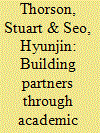

|
|
|
|
|
| Publication |
2014.
|
| Summary/Abstract |
Science can serve as an attractive mode for trust building and cooperative engagement between countries where formal political or diplomatic relations have been strained or are nonexistent. In this article we discuss some conditions and constraints for bilateral academic science engagement and suggest how such engagement might help to build trust between the United States and North Korea. We analyze longitudinal data on North Korea's diplomatic ties and international academic collaboration as well as US public opinion data to provide context for US-North Korea science engagement. We argue that bilateral academic science engagement should be attractive to the United States and North Korea and suggest a set of policy measures that might facilitate such engagement.
|
|
|
|
|
|
|
|
|
|
|
|
|
|
|
|
| 17 |
ID:
133588
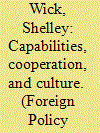

|
|
|
|
|
| Publication |
2014.
|
| Summary/Abstract |
The Sino-American relationship is arguably the most important bilateral relationship in the world. Whether this relationship remains peaceful or becomes conflictual will have far-reaching economic and political ramifications. For more than two decades, American analysts have been attempting to answer one question: Is China a threat to the United States? The result has been a voluminous collection of data that equally supports contradictory answers. I contend that if we want to understand the probable course of the Sino-American relationship, we need to ask a different question: When and why are Americans likely to perceive China as a threat? This paper reports the results of a social psychological experiment designed to explore the basis of American attitudes toward other states in general and toward China specifically. Contrary to expectations that economic insecurity drives American attitudes toward economic competitors, this study finds that American attitudes toward China are shaped primarily by cultural and institutional judgments. These results contribute to the field of IR by challenging preconceptions about the extent and potential impact of Americans' economic insecurities, by contributing to a nascent constructivist literature that examines how threat is constructed in the national imagination, and by informing how policymakers approach important bilateral relationships.
|
|
|
|
|
|
|
|
|
|
|
|
|
|
|
|
| 18 |
ID:
115953
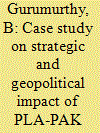

|
|
|
| 19 |
ID:
128894
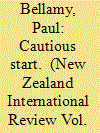

|
|
|
| 20 |
ID:
133739
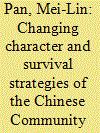

|
|
|
|
|
| Publication |
2014.
|
| Summary/Abstract |
The Chinese community has been settled in India for more than two centuries. Its relationship to the host society and to the authorities, first British and then Indian, has gone through different stages with different forms. It is important to examine the lives, traditions and attitudes of the Chinese community to understand its development and its changing character. This study argues that it is misleading to present this community as one that has always been marginalised and discriminated against in India. It examines the applicability of concepts such as 'sojourning', 'corridors' and 'middleman minority' to the community and its different sub-groups, both in British India and in post-independence India.
|
|
|
|
|
|
|
|
|
|
|
|
|
|
|
|